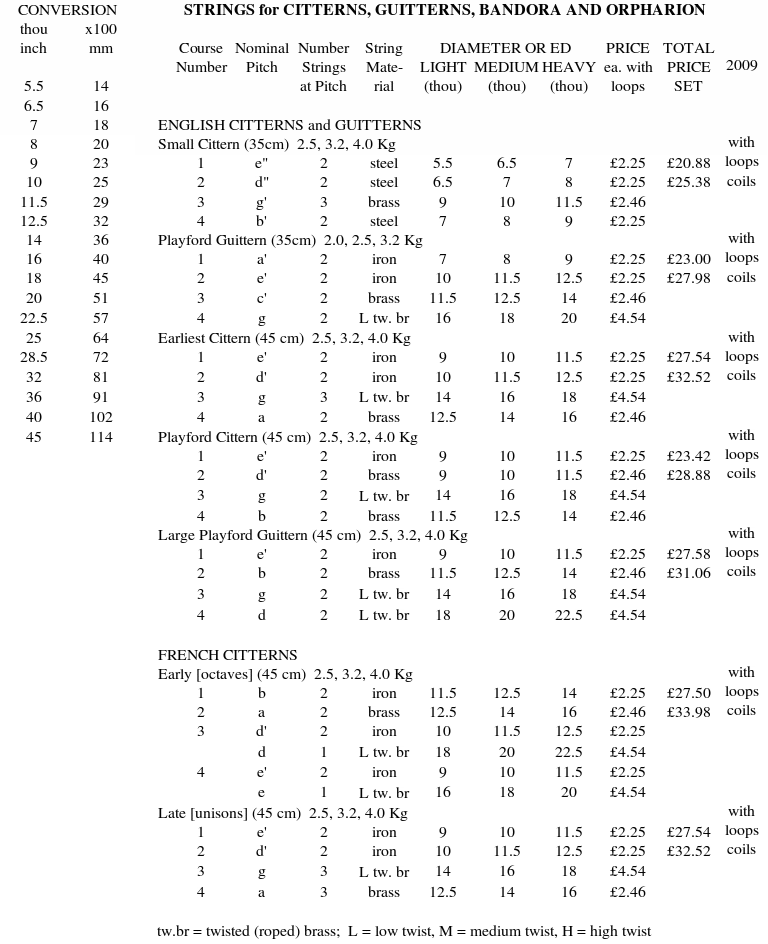
Northern Renaissance Instruments
6 Needham Avenue, Chorlton-cum-Hardy, Manchester M21 8AA, U.K.
Phone & Fax. +44 (0) 161 881 8134 ; proprietor: Dr. Ephraim Segerman [USA]
e-mail: post@nrinst.co.uk ; on internet: http://www.nrinst.co.uk
STRINGS FOR CITTERNS BANDORA AND ORPHARION
Historical background - England
English citterns almost always had 4 courses. The earliest ones, from before 1550 to about 1580, were adaptations of the French cittern. The repertoire used was mainly the French publications. Surviving native repertoire is in the Mulliner Book and occasional pieces in lute manuscripts. It was used also (but with no surviving music) in the early performances of the Consort of Six (with treble and bass viols, lute, flute and bandora) that so impressed Queen Elizabeth. Around 1580, when a much stronger ferrous wire became available from Jobst Meuler in Nuremberg, the small cittern (with a 35 cm string stop) tuned an octave higher (except that the 4th course was tuned a tone higher yet, a major third above the 3rd) quickly replaced it in fashionable circles. It was for this instrument that the great flowering of solo and Consort repertoire was written for in the following four decades.
Current fashion in early music is to use a larger cittern (with 45 cm string stop) for that flowering of repertoire. For stringing such instruments, one should follow either the Earliest Cittern (with the fourth course one thou lighter for the higher tuning) or the Playford Cittern in the stringing Table.
About 1600, Jobst Meuler was able to produce an even stronger wire, which allowed the small cittern to tune up to g", and some English players tuned it to gittern or octave-lute tuning. These are the tunings reported by Praetorius (1618). From about 1620, Jobst Meuler ceased producing any strong wire, and instruments that needed the strong wire for their tunings either became obsolete or were retuned to lower pitches using the iron that was available.
The small cittern, tuned an octave lower than the usual tuning, soon faded away, but its use tuned to a minor 7th lower than Praetorius's gittern tuning grew in popularity. By 1650, this instrument, in the latter tuning, was called 'guittern', and Playford wrote a book of music for it. By then, the cittern was revived as a simple instrument for beginners with a 45 cm string stop tuned an octave below the small cittern in its prime. Playford wrote a couple of books of tunes for it. More advanced musicians would probably have used these instruments for continuo accompaniments. The guittern was tuned an octave above the top four courses of a bandora, so bandora players could use it directly. Players of the guitar could restring the cittern relatively like a guittern and play it directly for continuo. Later in the 17th century, there is evidence for the 45 cm cittern and a guittern of about the same size, both with innovative body designs. By early in the next century, these instruments were well out of fashion.
The bandora was reported to have been invented by John Rose in 1562. The gittern (Renaissance guitar) and cittern were played by the same group of London gentlemen, and it is likely that the bandora was made for a gittern player to play with a cittern in the style of the treble-and-bass lute duets. In the 1570's, when high-twist roped brass strings (like gut bass strings) became available, the frets and bridge were angled to get the maximum open-string range of two octaves and a tone using these strings as basses with iron trebles. The bandora has a surviving solo repertoire, but was mainly used for continuo, and its popularity lasted till the end of the 17th century.
It seems that the Helmingham instrument by John Rose (1580) was originally designed as a 5-course cittern with some bandora design features, but as Jobst Meuler's strong strings had become available, it was adapted for 6-course lute tuning. It was amongst the first orpharions (if not the first). The orpharion was a wire-strung alternative for lute players, having very little independent repertoire. When Jobst Meuler's strings ceased to be available around 1620, some orpharions survived tuned like a bass lute and playing continuo, but most were abandoned.
Historical background - elsewhere
Printed books of cittern music started to appear in France in the middle of the 16th century. It was transcriptions of vocal part music with dance titles. In the transcriptions, the 3rd and 4th courses, having octave tuning, served for either high and low voices. The octave ambiguity led to chords that some did not like. By late in the century, the octave tuning in those courses seems to have been abandoned (as it was from the beginning when the English acquired the cittern from France).
While French citterns always had four courses, Italian citterns seem to always have had six. Praetorius wrote about the 'ordinary' 4-course cittern with two tunings, the French and the Italian. The difference was whether the 4th course was a tone or a third higher than the 3rd one. These were the common citterns played in Germany at the time, and the Italian tuning was not necessarily derived from a 4-course instrument played in Italy. Germans also used 5- and 6-course citterns with various tunings. There are 16th century German printed books of cittern music for 4-courses (early French tuning) and 6-courses (Kargel tuning). A mid-17th century German source mentioned only 4-course citterns, with the French tuning used more soloistically, and the Italian tuning used more for continuo. There were four sizes mentioned in the latter tuning with first courses at a' (Discant, at about 35 cm), e' (Alt at about 45 cm), b (Tenor), and probably a (Bass).
The standard tuning for Italian citterns mentioned by all authors was the hexachord tuning. There is hardly any surviving repertoire for it. In 1574, Virchi published a book of cittern music using an alternative tuning. The hand stretches required are like those in the English cittern repertoire, implying a string stop of about 35 cm. Some players of the standard-size cittern could have wanted to play some of Virchi's music or used his tuning otherwise, so a stringing for that size is also given.
The Stringing Tables
With gut stringing, players can just hear a difference in diameter of one semitone step, which is about 6%. With metal stringing, the difference is two steps, or about 12%. So that is the approximate difference between the specifications 'Light' and 'Medium', and 'Medium' and 'Heavy'. The tension specifications given after the name (and approximate string stop) are what the three columns of diameters were calculated from. When a string is made of twisted brass, the diameter given is the equivalent diameter (ED) of plain brass that has the same weight per unit length as the twisted string.
The string diameters (or ED's) listed are calculated for equal tension at a' = 440 Hz. There is no problem using them at a' = 415 Hz, at which the tension will be half-way between the tension specified for that column and for the one to the left of it. Different instruments respond differently, and different players have different preferences concerning sound balance, so stringing can be optimised by picking different courses from different columns, or even from outside the range shown. Nevertheless, a medium set is a safe choice for strings that should work reasonably well.
Praetorius gave string specifications for the small English cittern. With strings crossed to have the standard tuning, the gauges (German System) for courses 1 to 4 were 11, 10, 5 and 8, meaning 7, 8, 13 and 10 thou. According to the Table, the first two courses were Heavy, and the other two were extra-Heavy. Playford specified gauge 1 for the iron 1st course, and gauges 2 and 3 for the brass 2nd and 4th courses, meaning 8, 9 and 10 thou respectively. According to the Table, these were Medium for the first and extra-Light for the other two.
The composition of Jobst Meuler's strings is not known, and we have substituted modern steel. The iron and brass we offer are made by Malcolm Rose. The original specification of the 2nd course of the Early French cittern was that it was made of copper. We don't stock copper strings, and have substituted brass. We can make copper strings on special order. The 3rd course of Virchi's cittern was named 'Argentina', meaning 'silver'. The name could have been a traditional name for any Italian 3rd course, and indeed, plain silver strings could successfully substitute for any of the low-twist twisted brass strings listed for Italian tunings. We do not stock silver strings, but can make them to order.

